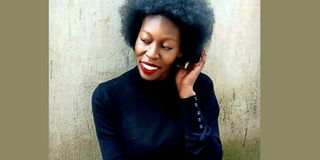One on one with fashion illustrator, Phoebe Ouma

Phoebe Ouma, 22, is a fourth year fashion design and marketing student at Machakos University. PHOTO | COURTESY
What you need to know:
- The fine art units I took in school definitely sparked my interest in different illustration mediums.
- I am a collaboration of the love I have for illustration, internet tutorials, books and learning from other artists.
- My dream was to be a fashion designer, but I loved drawing and creating fashion sketches.
Phoebe, 22 is a fourth year Fashion Design and Marketing student at Machakos University. Phoebe loves drawing and is intrigued by fashion editorials and photography. She is a fashion illustrator, and by piecing together images of African brands that inspire her, she tells a beautiful story of their craft in an art form that she hopes the world will know her for.
Did you study illustration or are you self-taught?
The fine art units I took in school definitely sparked my interest in different illustration mediums, but a semester in class is not enough to teach you how to illustrate. I am a collaboration of the love I have for illustration, internet tutorials, books and learning from other artists.
Can you remember the first illustration you saw and loved?
As a child, my mum often bought me Barbie dolls and Bratz dolls. There were beautiful illustrations on the boxes they came in. Before I knew any illustrators by name, or had access to the internet, I would collect these boxes.
Why did you choose fashion-illustration?
I would say it chose me. My dream was to be a fashion designer, but I loved drawing and creating fashion sketches. I had these two loves but I decided to pursue illustration first since I had the tools to do so at my disposal.
What is the role of an illustrator in the fashion industry?
The major role is to interpret fashion through the artistic lens of the illustrator. Just like fashion photography, it can act as tool to advertise, promote and create intrigue around fashion items. This industry is one that is very heavy on visuals, and it is nice to see different perspectives of it.
How do you go about illustrating and how long does it take you?
I’ll get my tools out - paintbrushes, pencils, erasers, tubes of paints, magazines, laptop and a paper to test the watercolour swatches on. I’ll usually have the image I want to work on printed out on the side or on my phone. I then start sketching on an A5 sketchbook, and when I’m comfortable with the concept, I redo it on watercolour paper. When I’m through, I scan it, clean it up on Photoshop and resize it to post on Instagram. The rough sketch can take 10 to 20 minutes, but if there are more details, it could take several hours. The more complex an image the longer it takes me.
Many artists struggle to set value for their work. How do you decide how much to charge for a project?
This has been a challenge for me as well. That said, to arrive at a figure, I consider the time I have put in as well as the creative input, such as details added that did not exist in the original photograph. I also consider deadline, materials used, size of the illustration and whether or not I will give the client the go-ahead to reproduce it commercially.
What are some common myths about your profession?
Most people would like to believe that this is just a hobby, so they don’t want to pay for work put in. Illustrations are an advertising tool that has been used for many years. This is a profession like any other.
What has been your greatest success?
Every artist wishes for two things - to have their work appreciated and to make a living while doing it. I wasn’t entirely sure how creatives such as designers and fashion lovers would perceive my art here and in Africa at large. Fashion illustrators aren’t that many here, so I’d have to say my biggest success is the overwhelming support and positive response I’ve gotten so far.
What tips can you give those interested in pursuing illustration?
You should be passionate because it will give you the will to learn and perfect your art. Don’t ape, embrace your style and work on achieving the best version of that.
It is also important to identify your target market, take time to understand potential customers and foster good relationships with them. A good business is built by a community of like-minded people who support it.




